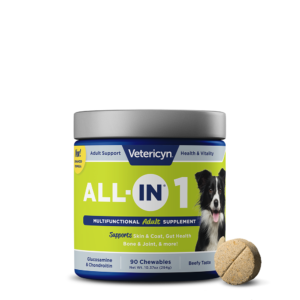Updated Sept 8, 2025
We all know how much our furry loved ones enjoy chowing down on their favorite foods and treats. We spend a lot of time, thought, and energy making sure the things they eat help keep our dogs healthy and happy. But rarely do we ask the question how long does it take a dog to digest food?
However, we also spend a lot of time cleaning up after our dogs. We pay close attention to their digestive responses as they are indicators paramount to assessing our dog’s health (although we’re often missing the important questions).
But, once again, what exactly goes into the dog’s digestion process?
The Canine Digestive System
Wondering how long a dog’s digestion process is? You’re not alone. Understanding how long it takes a dog to digest food helps us promote their digestive system and gain insights into their inner workings. For instance, according to the Innovative Veterinary Care Journal, human beings and dogs have their ingestion storage reversed; dogs contain 70% of their ingesta in their stomach and only 30% in their intestinal tract. Whereas humans reverse that construct and keep 30% in their stomachs and 70% in their intestinal tract.
Facts like these prove we have to look at how our four-legged friends’ digestive systems work to learn ways to promote their gut health and prevent digestive problems in the future.
Stages of Dog Digestion
Understanding the dog’s digestion process is key to keeping your pet healthy. It’s more than just food disappearing into your dog’s stomach. The digestive journey involves a series of important steps, and knowing what happens at each stage can help you support your dog’s digestive health.
- Mouth: The digestive process begins in your dog’s mouth. Just like humans, dogs chew their food, although some breeds, like bulldogs, tend to chew less. Saliva helps break down the food into smaller pieces, starting the process of digestion.
- Stomach: Once swallowed, the food moves down the esophagus and into the stomach, where it’s mixed with stomach acids and enzymes to further break down proteins and fats. The stomach can hold food for up to 4 hours, depending on the dog’s size and the type of food they ate.
- Small intestine: The food then moves into the small intestine, where most of the digestion and nutrient absorption happen. This process can take 3-5 hours, as enzymes from the pancreas and bile from the liver further break down food into nutrients.
- Large intestine: After nutrients are absorbed, the remaining waste moves into the large intestine, where water is absorbed and the waste is formed into stool. This final process can take another 12-24 hours.
It’s important to take a look at your dog’s digestive cycle as a whole. The process not only has an effect on your dog’s overall health and well-being, but it is also something that has to be monitored and nurtured over time. Your dog’s digestive needs will change based on their age, breed, and exercise routine. Be prepared to help promote their health by understanding their digestive needs.
Promoting Your Dog’s Digestion
While our pups like to think they can eat anything, the truth is they can’t. While there are several things your dog should never eat, there are also a myriad of factors that go into promoting your dog’s digestive health.
As you’ll deduce once we break down the various components of dog digestion, when you promote their digestive health, you promote their entire well-being. That means understanding from start to finish the digestion cycle and the factors that go into your dog’s digestion.
Factors That Go Into Your Dog’s Digestion
Each dog is unique. Just as each pup has its own personality and traits, each dog breed has a myriad of factors that affect their digestive system. In fact, according to PetMD, the canine digestive system takes anywhere from 8 to 10 hours to digest a meal fully, but it can take as long as 12 or as quick as four, depending on your dog’s breed and the type of food consumed.
Even with these varying digestion cycles, we still find that there are key digestive factors you can monitor that are ubiquitous across dog breeds:
- The size of your dog – The size of your dog is one of the most significant factors that go into how long it takes your dog to digest food. Depending on your breed, a full-grown adult dog can range from a chihuahua of 5lbs to an anatolian shepherd of 120 pounds.
- Breed of dog – Breed is the single most affecting element to any variance in dog traits. That being said, while sizes are interchangeable, dog breeds are not. Understanding what weights are typical for your dog can help protect their digestive health before any problems become significant.
- Age is the x-factor – Since the size of your dog and the breed of the dog are connected biologically, age is the x-factor in determining the characteristics that go into your dog’s digestive health. Just as puppies tend to use the restroom more often, and the aging dog’s metabolism wanes, age is the key variable in understanding the length of the digestive process. Generally, the older the dog, the longer the process (just like us!).
- The role exercise plays – Exercise is an important factor in your dog’s overall health and well-being. But it affects the digestive process of your dog as well. The more energy your dog expends, the faster their body will take the energy stored in their stomach and send it through their intestinal tract. There, it’s burned into caloric energy supplemental to the output of physical strength. Always keep a close eye on managing their energy input and output. Just like you, if you’re not active and yet you’re eating your weight in calories, your digestive system isn’t going to be happy. Yet, if you’re extremely active, you’ll need the proper caloric intake for balance.
- What they are eating – While this might seem obvious, different foods digest at different speeds. For example, larger amounts of grain are digested slower than those meals full of protein. A dog’s digestive tract will crave certain foods based on where it is in the process. Take an extra look at your feeding strategy. It could make all the difference.
Quick Tips to Support Healthy Digestion in Your Dog
Helping your dog digest food more efficiently can lead to fewer digestive issues. Here are some quick tips:
- Smaller, more frequent meals: Feeding your dog smaller portions throughout the day instead of one large meal can help prevent overeating and promote smoother digestion.
- Balanced diet: Ensure your dog’s diet is well-balanced, with a mix of protein, fiber, and healthy fats. Consider feeding foods that are easy on the stomach, like high-quality dog food made with natural ingredients.
- Hydration: Always ensure your dog has access to fresh water. Dehydration can lead to constipation and other digestive issues, so hydration is key.
- Probiotics and digestive enzymes: Adding a digestive supplement, like Vetericyn’s dog supplements, can help your dog maintain a healthy gut. These supplements support the natural balance of bacteria in the stomach, aiding in food breakdown and nutrient absorption.
- Exercise: Regular physical activity helps improve digestion and speed up metabolism, which can prevent bloating and discomfort after meals.

Signs Your Dog May Have Gastrointestinal Problems
If you’re concerned about your dog’s digestion, keep an eye out for these common signs:
- Vomiting or diarrhea: Persistent vomiting or diarrhea can indicate an issue with your dog’s digestive system and may require veterinary attention.
- Lack of appetite: If your dog isn’t interested in eating, it could be a sign of digestive discomfort or an underlying health issue.
- Bloating: If your dog’s abdomen seems swollen or tender to the touch, it could indicate an issue with digestion or even a more serious condition like bloat (gastric dilatation-volvulus, or GDV).
If your dog is showing any of these signs, it’s important to consult your veterinarian for advice.
Always Consult With Your Veterinarian
It’s always prudent to consult with your veterinarian when starting your dog on a new diet. If you see any signs or symptoms of dog indigestion, consult with your veterinarian immediately. Although there are effective ways to help treat indigestion in dogs overall, it’s probably best that you seek the advice of a professional.
Dog Vitamins and Supplements to Support Digestive Health
One of the most effective ways to promote a healthy digestive cycle in your dog is through vitamins and supplements. Vitamins and supplements aid your dog’s digestive system. That’s their whole purpose. Adding a digestive aid to your dog’s diet can help improve indigestion, allow him to digest food more easily, and keep the GI tract moving how it should.
While some vitamin and supplement companies would have you believe “more, more, more,” overuse of supplements won’t provide your pup with the vitamins and nutrients they need, but will instead overload their system with unabsorbable leftovers.
The key is to find the perfect, all-in-one supplement for your companion.
Take Vetericyn’s ALL-IN supplement, for example: it’s age-specific, and supports your dog’s immune system, joints, mental health, gut health, and more. It’s a complete multivitamin that promotes a dog’s key anatomical systems in one go. The supplement uses grass-fed organ meat complex and is designed to be nutrient-heavy and fully absorbable, so your dog reaps the benefits but isn’t overloaded by the contents.

How Long Does it Take a Dog to Digest Food?
The simple answer? Depends on your dog. With breed, age, exercise, diet and the organs that make up a dog’s digestive cycle, the digestive tract is one of the hardest areas to monitor in our furry friends.
- Generally, for small dogs and puppies, it’s four hours or so.
- For larger dogs, about eight.
Now that you’re armed with this information, you can begin to take preventative measures to ensure optimum gut health in your dog!
 Reviewed by Dr. Kathy Adamson
Reviewed by Dr. Kathy Adamson
Dr. Kathy Adamson earned her bachelor’s degree from the University of Notre Dame and her Doctor of Veterinary Medicine degree from the University of Wisconsin-Madison School of Veterinary Medicine.
She completed a one-year small animal medicine and surgery internship at the North Carolina State College of Veterinary Medicine. Alongside her studies, Kathy worked in a research lab, contributing as an author and co-author to various journal articles.
She has also pursued medical writing and editing certification through the University of Chicago Graham School. Currently, she runs KMA Veterinary & Medical Writing, a freelance medical writing company, serves as the Digital Content Manager for the Greater Chicago Area Chapter of the American Medical Writers Association, is a member of the AMWA Communications Committee, and enjoys writing about healthcare topics for people and their cherished pets.
![]() https://www.linkedin.com/in/kathyadamsondvm/
https://www.linkedin.com/in/kathyadamsondvm/
Sources:
- AKC.OG . Breed Weight Chart.
- https://www.akc.org/expert-advice/nutrition/breed-weight-chart/
- Vet Med. Digestive System of the Dog.
- https://www.vetmed.wsu.edu/outreach/Pet-Health-Topics/categories/cat-and-dog-anatomy/digestive-system-of-the-dog
- IVC Journal. Understanding Pet Digestion. https://ivcjournal.com/understanding-pet-digestion/

